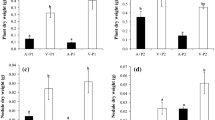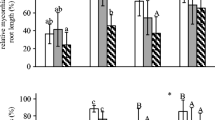Abstract
Background and aims
The changes in the characteristics of Panicum virgatum, an exotic invasive species, after invading various plant communities on the Loess Plateau in China and the main soil nutrient factors in these communities closely associated with invasion remain unclear.
Methods
A pot culture experiment was carried out to simulate the changes in photosynthesis, biomass, and biomass allocation in P. virgatum and to identify the main soil nutrient factors in various soils collected from local plant communities. P. virgatum was grown in soils collected from communities of P. virgatum (PS treatment), Setaria viridis (SS treatment), Bothriochloa ischaemum (BS treatment), and Artemisia sacrorum (AS treatment) and in a mixed soil from the communities of S. viridis, B. ischaemum, and A. sacrorum (MS treatment).
Results
Photosynthesis in P. virgatum differed significantly among the soil treatments. Net photosynthetic rate, stomatal conductance, and photochemical efficiency (Fv/Fm) were highest in PS, whereas single-photon avalanche diode values were highest in PS and SS. The variation of biomass differed significantly in different tissues of P. virgatum in the treatments. Leaf and stem biomasses were highest in PS and SS, and root biomass was highest in PS and MS. Total biomass differed significantly among the treatments, except between BS and MS. Both the leaf to total and stem to total biomass ratios were highest in AS and SS, but the root to total biomass ratio was lowest in these two treatments. A constrained redundancy analysis and a path analysis suggested that the water-soluble nitrate-nitrogen (W-NN) concentration of the soil could significantly affect photosynthesis, biomass, and biomass allocation in P. virgatum.
Conclusions
Photosynthesis, biomass, and biomass allocation in P. virgatum differed significantly when grown in soils from different local plant communities on the Loess Plateau. The soil W-NN concentration in these local plant communities likely has a large impact on the invasive success of P. virgatum.






Similar content being viewed by others
References
Ali M, Fahej S (2012) Screening switchgrass (Panicum virgatum L.) for water stress tolerance. Dissertations & Theses - Gradworks
An Y, Ma YQ, Shui JF (2014) Switchgrass (Panicum virgatum L.) plants and switchgrass residue reduce the biomass and density of associated weeds. Acta Agriculturae Scandinavica, Section B — Soil & Plant Science 63:107–113
Anderson LJ, Cipollini D (2013) Gas exchange, growth, and defense responses of invasive Alliaria petiolata (Brassicaceae) and native Geum vernum (Rosaceae) to elevated atmospheric CO2 and warm spring temperatures. Am J Bot 100:1544–1554
Björkman O, Demmig B (1987) Photon yield of O2 evolution and chlorophyll fluorescence characteristics at 77 K among vascular plants of diverse origins. Planta 170:489–504
Bleier JS, Jackson RD (2007) Manipulating the quantity, quality, and manner of C addition to reduce soil inorganic N and increase C4:C3 rass biomass. Restor Ecol 15:688–695
Bouranis DL, Dionias A, Chorianopoulou SN, Liakopoulos G, Nikolopoulos D (2014) Distribution profiles and interrelations of stomatal conductance, transpiration rate and water dynamics in young maize laminas under nitrogen deprivation. Am J Plant Sci 5:659–670
Bowman WD, Theodose TA, Schardt JC, Conant RT (1993) Constraints of nutrient availability on primary production in two alpine tundra communities. Ecology 74:2085–2097
Bremner J, Mulvaney C (1982) Nitrogen-total methods of soil analysis, part 2, chemical and microbiological properties. American Society of Agronomy. Inc, Publisher, USA
Bussotti F, Pollastrini M, Holland V, Brüggemann W (2015) Functional traits and adaptive capacity of European forests to climate change. Environ Exp Bot 111:91–113
Butler W, Kitajima M (1975) Fluorescence quenching in photosystem II of chloroplasts. Biochimica et Biophysica Acta (BBA)-Bioenergetics 376:116–125
Casler M, Mitchell R, Vogel K (2012) Switchgrass. Handbook of Bioenergy Crop Plants: 563–590
Chai L-Y, Mubarak H, Yang Z-H, Yong W, Tang C-J, Mirza N (2016) Growth, photosynthesis, and defense mechanism of antimony (Sb)-contaminated Boehmeria nivea L. Environ Sci Pollut Res 23:7470–7481
Chapin FS, Bloom AJ, Field CB, Waring RH (1987) Plant responses to multiple environmental factors. Bioscience 37:49–57
Chazdon RL, Pearcy RW, Lee DW, Fetcher N (1996) Photosynthetic responses of tropical forest plants to contrasting light environments. Springer
Daehler CC (2003) Performance comparisons of co-occurring native and alien invasive plants: implications for conservation and restoration. Ecology, Evolution, and Systematics 34:183–211
Durand LZ, Goldstein G (2001) Photosynthesis, photoinhibition, and nitrogen use efficiency in native and invasive tree ferns in Hawaii. Oecologia 126:345–354
Ehrenfeld JG (2003) Effects of exotic plant invasions on soil nutrient cycling processes. Ecosystems 6:503–523
Ehrenfeld JG, Kourtev P, Huang W (2001) Changes in soil functions following invasions of exotic understory plants in deciduous forests. Ecol Appl 11:1287–1300
Ewe SML (2005) Growth and gas exchange responses of Brazilian pepper (Schinus terebinthifolius) and native South Florida species to salinity. Trees 19:119–128
Funk JL, Vitousek PM (2007) Resource-use efficiency and plant invasion in low-resource systems. Nature 446:1079–1081
Glynn C, Herms DA, Egawa M, Hansen R, Mattson WJ (2003) Effects of nutrient availability on biomass allocation as well as constitutive and rapid induced herbivore resistance in poplar. Oikos 101:385–397
Huang J, Gao Z, Chen J, Zhang H, Bingcheng XU (2016) Diurnal and seasonal variations of soil respiration rate under different row-spacing in a Panicum virgatum L. field on semi-arid Loess Plateau of China. Journal of Arid Land 8:341–349
Jarosch K (2012) Desorption of water soluble phosphorus from soil. Slu Dept of Soil & Environment
Johnson NC, Rowland DL, Corkidi L, Allen EB (2008) Plant winners and losers during grassland N-eutrophication differ in biomass allocation and mycorrhizas. Ecology 89:2868–2878
Jones DL, Willett VB (2006) Experimental evaluation of methods to quantify dissolved organic nitrogen (DON) and dissolved organic carbon (DOC) in soil. Soil Biol Biochem 38:991–999
Kaokniffin J, Balser TC (2008) Soil fertility and the impact of exotic invasion on microbial communities in Hawaiian forests. Microb Ecol 56:55–63
Kurai T, Wakayama M, Abiko T, Yanagisawa S, Aoki N, Ohsugi R (2011) Introduction of the ZmDof1 gene into rice enhances carbon and nitrogen assimilation under low-nitrogen conditions. Plant Biotechnol J 9:826–837
Leffler AJ, James JJ, Monaco TA, Sheley RL (2014) A new perspective on trait differences between native and invasive exotic plants. Ecology 95:298–305
Liao C et al (2008) Altered ecosystem carbon and nitrogen cycles by plant invasion: a meta-analysis. New Phytol 177:706–714
Ma YQ, An Y, Shui JF, Sun ZJ, Stewart N, Liu GS (2011) Adaptability evaluation of switchgrass (Panicum virgatum L.) cultivars on the Loess Plateau of China. Plant Science An International Journal of Experimental Plant Biology 181:638–643
Maxwell K, Johnson GN (2000) Chlorophyll fluorescence—a practical guide. J Exp Bot 51:659–668
Mcallister CH, Beatty PH, Good AG (2012) Engineering nitrogen use efficient crop plants: the current status. Plant Biotechnol J 10:1011–1025
Mcdowell SC (2002) Photosynthetic characteristics of invasive and noninvasive species of Rubus (Rosaceae). Am J Bot 89:1431–1438
Miller AJ, Fan X, Shen Q, Smith SJ (2008) Amino acids and nitrate as signals for the regulation of nitrogen acquisition. J Exp Bot 59:111–119
Müller I, Schmid B, Weiner J (2000) The effect of nutrient availability on biomass allocation patterns in 27 species of herbaceous plants. Perspect Plant Ecol 3:115–127
Näsholm T, Kielland K, Ganeteg U (2009) Uptake of organic nitrogen by plants. New Phytol 182:31–48
Netto AT, Campostrini E, de Oliveira JG, Bressan-Smith RE (2005) Photosynthetic pigments, nitrogen, chlorophyll a fluorescence and SPAD-502 readings in coffee leaves. Sci Hortic 104:199–209
Niu J, Feng Z, Zhang W, Zhao P, Wang X (2014) Non-stomatal limitation to photosynthesis in Cinnamomum camphora seedings exposed to elevated O3. PLoS One 9:e98572
Olsen S, Sommers L, Page A (1982) Methods of soil analysis. Part 2. Chemical and microbiological properties of phosphorus ASA monograph: 403–430
Onoda Y, Hikosaka K, Hirose T (2004) Allocation of nitrogen to cell walls decreases photosynthetic nitrogen-use efficiency. Funct Ecol 18:419–425
Panda D, Sarkar RK, Sharma SG (2008) Chlorophyll fluorescence parameters, CO2 photosynthetic rate and regeneration capacity as a result of complete submergence and subsequent re-emergence in rice (Oryza sativa L.) Aquat Bot 88:127–133
Percival GC, Sheriffs CN (2002) Identification of drought-tolerant woody perennials using chlorophyll fluorescence. J Arboric 28:215–223
Peterson TA, Blackmer TM, Francis DD, Schepers JS (1993) G93–1171 Using a chlorophyll meter to improve N management. Historical materials from University of Nebraska-Lincoln Extension: 1353
Pierangelini M, Stojkovic S, Orr PT, Beardall J (2014) Photosynthetic characteristics of two Cylindrospermopsis raciborskii strains differing in their toxicity. J Phycol 50:292–302
Pyšek P, Richardson DM (2007) Traits associated with invasiveness in alien plants: where do we stand? In: Biological invasions. Springer, pp 97–125
Reichmann LG, Schwinning S, Polley HW, Fay PA (2016) Traits of an invasive grass conferring an early growth advantage over native grasses. J Plant Ecol
Roiloa S, Retuerto R (2006) Small-scale heterogeneity in soil quality influences photosynthetic efficiency and habitat selection in a clonal plant. Ann Bot 98:1043–1052
Sala OE et al (2000) Global biodiversity scenarios for the year 2100. Science 287:1770–1774
Seemann JR (1989) Light adaptation/acclimation of photosynthesis and the regulation of ribulose-1, 5-bisphosphate carboxylase activity in sun and shade plants. Plant Physiol 91:379–386
Sherrard ME, Joers LC, Carr CM, Cambardella CA (2015) Soil type and species diversity influence selection on physiology in Panicum virgatum. Evol Ecol 29:679–702
Shipley B (2006) Net assimilation rate, specific leaf area and leaf mass ratio: which is most closely correlated with relative growth rate? A meta-analysis. Funct Ecol 20:565–574
Shui JF, An Y, Ma YQ, Ichizen N, Zhuang J (2010) Allelopathic potential of switchgrass (Panicum virgatum L.) on perennial ryegrass (Lolium perenne L.) and alfalfa (Medicago sativa L.) Environ Manag 46:590–598
Verhoeven KJ, Biere A, Nevo E, van Damme JM (2004) Differential selection of growth rate-related traits in wild barley, Hordeum spontaneum, in contrasting greenhouse nutrient environments. J Evol Biol 17:184–196
Vilà M et al (2010) How well do we understand the impacts of alien species on ecosystem services? A pan-European, cross-taxa assessment. Front Ecol Environ 8:135–144
Weidenhamer JD, Callaway RM (2010) Direct and indirect effects of invasive plants on soil chemistry and ecosystem function. J Chem Ecol 36:59–69
Werf AVD, Nagel OW (1996) Carbon allocation to shoots and roots in relation to nitrogen supply is mediated by cytokinins and sucrose: opinion. Plant Soil 185:21–32
Xu BC, Li FM, Shan L (2008) Switchgrass and milkvetch intercropping under 2: 1 row-replacement in semiarid region, northwest China: aboveground biomass and water use efficiency. Eur J Agron 28:485–492
Zhang C, Xue S, Liu GB, Song ZL (2011) A comparison of soil qualities of different revegetation types in the Loess Plateau, China. Plant Soil 347:163–178
Zuppinger-Dingley D, Schmid B, Chen Y, Brandl H, Van der Heijden MGA, Joshi J (2011) In their native range, invasive plants are held in check by negative soil-feedbacks. Ecosphere 2:1157–1165
Acknowledgements
We thank the anonymous referees and editors of the journal who provided valuable comments and suggestions on our manuscript. This research was funded by the Natural Science Foundation of China (41371510, 41671513, 41471438) and the West Young Scholars Project of The Chinese Academy of Sciences (XAB2015A05).
Author information
Authors and Affiliations
Corresponding author
Additional information
Responsible Editor: Leslie A. Weston .
Rights and permissions
About this article
Cite this article
Ai, Z., Zhang, J., Liu, H. et al. Soil nutrients influence the photosynthesis and biomass in invasive Panicum virgatum on the Loess Plateau in China. Plant Soil 418, 153–164 (2017). https://doi.org/10.1007/s11104-017-3286-x
Received:
Accepted:
Published:
Issue Date:
DOI: https://doi.org/10.1007/s11104-017-3286-x




